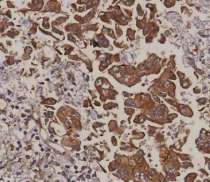ARG44142
anti-MGAT3 antibody
anti-MGAT3 antibody for IHC-Formalin-fixed paraffin-embedded sections,Western blot and Human
Overview
| Product Description | Rabbit Polyclonal recognizes MGAT3 |
|---|---|
| Tested Reactivity | Hu |
| Tested Application | IHC-P, WB |
| Host | Rabbit |
| Clonality | Polyclonal |
| Isotype | IgG |
| Target Name | MGAT3 |
| Antigen Species | Human |
| Immunogen | Human MGAT3 recombinant protein (Position: D68-N437). |
| Conjugation | Un-conjugated |
| Alternate Names | MGAT3; Beta-1,4-Mannosyl-Glycoprotein 4-Beta-N-Acetylglucosaminyltransferase; GNT-III; N-Glycosyl-Oligosaccharide-Glycoprotein N-Acetylglucosaminyltransferase III; Mannosyl (Beta-1,4-)-Glycoprotein Beta-1,4-N-Acetylglucosaminyltransferase; N-Acetylglucosaminyltransferase III; GlcNAc-T III; EC 2.4.1.144; GGNT3; GNT3 |
Application Instructions
| Application Suggestion |
|
||||||
|---|---|---|---|---|---|---|---|
| Application Note | The dilutions indicate recommended starting dilutions and the optimal dilutions or concentrations should be determined by the scientist. |
Properties
| Form | Liquid |
|---|---|
| Purification | Affinity purification with immunogen. |
| Buffer | 0.9% NaCl, 0.2% Na2HPO4, 0.05% Sodium azide and 4% Trehalose. |
| Preservative | 0.05% Sodium azide |
| Stabilizer | 4% Trehalose |
| Concentration | 0.5 mg/ml |
| Storage Instruction | For continuous use, store undiluted antibody at 2-8°C for up to a week. For long-term storage, aliquot and store at -20°C or below. Storage in frost free freezers is not recommended. Avoid repeated freeze/thaw cycles. Suggest spin the vial prior to opening. The antibody solution should be gently mixed before use. |
| Note | For laboratory research only, not for drug, diagnostic or other use. |
Bioinformation
| Database Links |
Swiss-port # Q09327 Human Beta-1,4-mannosyl-glycoprotein 4-beta-N-acetylglucosaminyltransferase |
|---|---|
| Gene Symbol | MGAT3 |
| Gene Full Name | mannosyl (beta-1,4-)-glycoprotein beta-1,4-N-acetylglucosaminyltransferase |
| Background | There are believed to be over 100 different glycosyltransferases involved in the synthesis of protein-bound and lipid-bound oligosaccharides. The enzyme encoded by this gene transfers a GlcNAc residue to the beta-linked mannose of the trimannosyl core of N-linked oligosaccharides and produces a bisecting GlcNAc. Multiple alternatively spliced variants, encoding the same protein, have been identified. |
| Function | It is involved in the regulation of the biosynthesis and biological function of glycoprotein oligosaccharides. Catalyzes the addition of N-acetylglucosamine in beta 1-4 linkage to the beta-linked mannose of the trimannosyl core of N-linked sugar chains, called bisecting N-acetylglucosamine (GlcNAc). It is one of the most important enzymes involved in the regulation of the biosynthesis of glycoprotein oligosaccharides. The addition of this bisecting GlcNAc residue alters not only the composition, but also the conformation of the N-glycan. The introduction of the bisecting GlcNAc residue results in the suppression of further processing and elongation of N-glycans, precluding the formation of beta-1,6 GlcNAc branching, catalyzed by MGAT5 since it is unable to use the bisected oligosaccharide as a substrate. |
| Cellular Localization | Golgi apparatus, Membrane |
| Calculated MW | 61 kDa |
| PTM | Glycoprotein |
Images (2) Click the Picture to Zoom In







